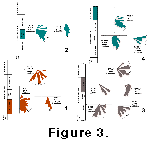RESULTS
 Over 250
paleocurrent measurements were taken for the three defined members of the
Chitarwata Formation at Dalana (Downing et al. 1993) and the lowermost major
sandstone units of the overlying Vihowa Formation. The stratigraphic placement
of our sandstone reference units, the sedimentary structures evaluated,
respective numbers of measurements, mean resultant directions and sense, 95%
confidence intervals for directions, and maximum percentages are specified in
Table 2. The corresponding rose diagrams for the sandstone units are presented
in stratigraphic order in Figure 3.
Over 250
paleocurrent measurements were taken for the three defined members of the
Chitarwata Formation at Dalana (Downing et al. 1993) and the lowermost major
sandstone units of the overlying Vihowa Formation. The stratigraphic placement
of our sandstone reference units, the sedimentary structures evaluated,
respective numbers of measurements, mean resultant directions and sense, 95%
confidence intervals for directions, and maximum percentages are specified in
Table 2. The corresponding rose diagrams for the sandstone units are presented
in stratigraphic order in Figure 3.
Our paleocurrent
results for lower Chitarwata Formation indicate a predominant southeastward mean
resultant direction for the planar crossbedding evaluated in unit RS 7 (Figure
3.1). This is in general agreement with the more sparse data from trough axes in
RS 7. An almost due-southward mean resultant direction is implied by unit RS 16,
but it displays a notably high degree of directional variability. Results for
planar crossbedding and trough axes in unit RS 24 in the middle unit of the
Chitarwata Formation (Figure 3.2) are similar to those of unit RS 7, supporting
a prevailing southeastward mean resultant direction.
Flow directions for
the upper unit of the Chitarwata Formation were obtained from units RS 51 and RS
54 at Dalana and generally imply southward flow and drainage for the next
interval of deposition (Figure 3.3). Directional flow to the south and to the
southwest is supported by planar crossbedding in unit RS 51 and trough
crossbedding axes in unit RS 54 L (lower), respectively. With moderate variance,
trough crossbedding in RS 51 and RS 54 U (upper) in combination with sparse
planar crossbedding data from RS 54 indicates southeastward flow. Southeastward
drainage is supported by trough crossbedding and planar crossbedding data for
the lowermost major sandstone units of the Vihowa Formation, RS 59-60 and RS
62-63 (Figure 3.4).
In aggregate, our paleocurrent data at Zinda Pir
Dome for the Chitarwata and lower portion of the Vihowa Formation reflects a
predominant southeastward mean resultant direction with some occasional
deviation of current flow to the southwest and east. Our results are in general
agreement with the previous results of
Waheed and Wells (1990) at Chaudwan Zam
through the Chitarwata Formation (their unit Ic). However, where they found a
southwestward dominant drainage component at Raki Nala (their unit Ir), only the
upper unit at Dalana has a distinct southwestward flow component. Altogether,
exclusive of the distinctive cases for the suture zone and Katawaz Basin, the
available paleocurrent information in the literature and this study support a
dominant southeastward paleodrainage trend from the early Eocene through the
Miocene in the Pakistan Himalayan foreland.

 Over 250
paleocurrent measurements were taken for the three defined members of the
Chitarwata Formation at Dalana (Downing et al. 1993) and the lowermost major
sandstone units of the overlying Vihowa Formation. The stratigraphic placement
of our sandstone reference units, the sedimentary structures evaluated,
respective numbers of measurements, mean resultant directions and sense, 95%
confidence intervals for directions, and maximum percentages are specified in
Table 2. The corresponding rose diagrams for the sandstone units are presented
in stratigraphic order in Figure 3.
Over 250
paleocurrent measurements were taken for the three defined members of the
Chitarwata Formation at Dalana (Downing et al. 1993) and the lowermost major
sandstone units of the overlying Vihowa Formation. The stratigraphic placement
of our sandstone reference units, the sedimentary structures evaluated,
respective numbers of measurements, mean resultant directions and sense, 95%
confidence intervals for directions, and maximum percentages are specified in
Table 2. The corresponding rose diagrams for the sandstone units are presented
in stratigraphic order in Figure 3.